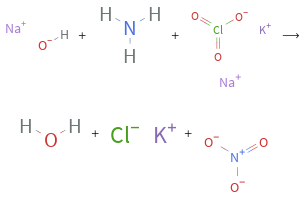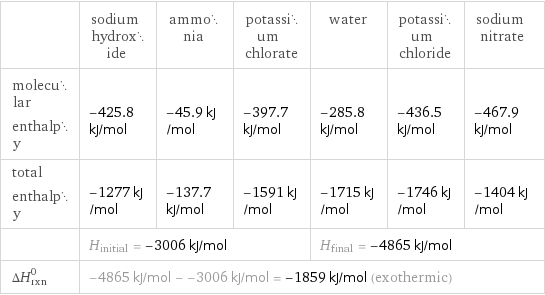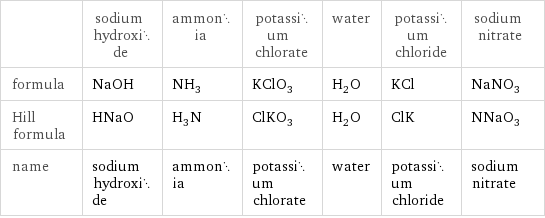Input interpretation

NaOH sodium hydroxide + NH_3 ammonia + KClO_3 potassium chlorate ⟶ H_2O water + KCl potassium chloride + NaNO_3 sodium nitrate
Balanced equation

Balance the chemical equation algebraically: NaOH + NH_3 + KClO_3 ⟶ H_2O + KCl + NaNO_3 Add stoichiometric coefficients, c_i, to the reactants and products: c_1 NaOH + c_2 NH_3 + c_3 KClO_3 ⟶ c_4 H_2O + c_5 KCl + c_6 NaNO_3 Set the number of atoms in the reactants equal to the number of atoms in the products for H, Na, O, N, Cl and K: H: | c_1 + 3 c_2 = 2 c_4 Na: | c_1 = c_6 O: | c_1 + 3 c_3 = c_4 + 3 c_6 N: | c_2 = c_6 Cl: | c_3 = c_5 K: | c_3 = c_5 Since the coefficients are relative quantities and underdetermined, choose a coefficient to set arbitrarily. To keep the coefficients small, the arbitrary value is ordinarily one. For instance, set c_1 = 1 and solve the system of equations for the remaining coefficients: c_1 = 1 c_2 = 1 c_3 = 4/3 c_4 = 2 c_5 = 4/3 c_6 = 1 Multiply by the least common denominator, 3, to eliminate fractional coefficients: c_1 = 3 c_2 = 3 c_3 = 4 c_4 = 6 c_5 = 4 c_6 = 3 Substitute the coefficients into the chemical reaction to obtain the balanced equation: Answer: | | 3 NaOH + 3 NH_3 + 4 KClO_3 ⟶ 6 H_2O + 4 KCl + 3 NaNO_3
Structures

+ + ⟶ + +
Names

sodium hydroxide + ammonia + potassium chlorate ⟶ water + potassium chloride + sodium nitrate
Reaction thermodynamics
Enthalpy

| sodium hydroxide | ammonia | potassium chlorate | water | potassium chloride | sodium nitrate molecular enthalpy | -425.8 kJ/mol | -45.9 kJ/mol | -397.7 kJ/mol | -285.8 kJ/mol | -436.5 kJ/mol | -467.9 kJ/mol total enthalpy | -1277 kJ/mol | -137.7 kJ/mol | -1591 kJ/mol | -1715 kJ/mol | -1746 kJ/mol | -1404 kJ/mol | H_initial = -3006 kJ/mol | | | H_final = -4865 kJ/mol | | ΔH_rxn^0 | -4865 kJ/mol - -3006 kJ/mol = -1859 kJ/mol (exothermic) | | | | |
Gibbs free energy

| sodium hydroxide | ammonia | potassium chlorate | water | potassium chloride | sodium nitrate molecular free energy | -379.7 kJ/mol | -16.4 kJ/mol | -296.3 kJ/mol | -237.1 kJ/mol | -408.5 kJ/mol | -366 kJ/mol total free energy | -1139 kJ/mol | -49.2 kJ/mol | -1185 kJ/mol | -1423 kJ/mol | -1634 kJ/mol | -1098 kJ/mol | G_initial = -2374 kJ/mol | | | G_final = -4155 kJ/mol | | ΔG_rxn^0 | -4155 kJ/mol - -2374 kJ/mol = -1781 kJ/mol (exergonic) | | | | |
Entropy

| sodium hydroxide | ammonia | potassium chlorate | water | potassium chloride | sodium nitrate molecular entropy | 64 J/(mol K) | 193 J/(mol K) | 143 J/(mol K) | 69.91 J/(mol K) | 83 J/(mol K) | 116 J/(mol K) total entropy | 192 J/(mol K) | 579 J/(mol K) | 572 J/(mol K) | 419.5 J/(mol K) | 332 J/(mol K) | 348 J/(mol K) | S_initial = 1343 J/(mol K) | | | S_final = 1099 J/(mol K) | | ΔS_rxn^0 | 1099 J/(mol K) - 1343 J/(mol K) = -243.5 J/(mol K) (exoentropic) | | | | |
Equilibrium constant
![Construct the equilibrium constant, K, expression for: NaOH + NH_3 + KClO_3 ⟶ H_2O + KCl + NaNO_3 Plan: • Balance the chemical equation. • Determine the stoichiometric numbers. • Assemble the activity expression for each chemical species. • Use the activity expressions to build the equilibrium constant expression. Write the balanced chemical equation: 3 NaOH + 3 NH_3 + 4 KClO_3 ⟶ 6 H_2O + 4 KCl + 3 NaNO_3 Assign stoichiometric numbers, ν_i, using the stoichiometric coefficients, c_i, from the balanced chemical equation in the following manner: ν_i = -c_i for reactants and ν_i = c_i for products: chemical species | c_i | ν_i NaOH | 3 | -3 NH_3 | 3 | -3 KClO_3 | 4 | -4 H_2O | 6 | 6 KCl | 4 | 4 NaNO_3 | 3 | 3 Assemble the activity expressions accounting for the state of matter and ν_i: chemical species | c_i | ν_i | activity expression NaOH | 3 | -3 | ([NaOH])^(-3) NH_3 | 3 | -3 | ([NH3])^(-3) KClO_3 | 4 | -4 | ([KClO3])^(-4) H_2O | 6 | 6 | ([H2O])^6 KCl | 4 | 4 | ([KCl])^4 NaNO_3 | 3 | 3 | ([NaNO3])^3 The equilibrium constant symbol in the concentration basis is: K_c Mulitply the activity expressions to arrive at the K_c expression: Answer: | | K_c = ([NaOH])^(-3) ([NH3])^(-3) ([KClO3])^(-4) ([H2O])^6 ([KCl])^4 ([NaNO3])^3 = (([H2O])^6 ([KCl])^4 ([NaNO3])^3)/(([NaOH])^3 ([NH3])^3 ([KClO3])^4)](../image_source/5709d1877f9934cb989ea336a9a69c6e.png)
Construct the equilibrium constant, K, expression for: NaOH + NH_3 + KClO_3 ⟶ H_2O + KCl + NaNO_3 Plan: • Balance the chemical equation. • Determine the stoichiometric numbers. • Assemble the activity expression for each chemical species. • Use the activity expressions to build the equilibrium constant expression. Write the balanced chemical equation: 3 NaOH + 3 NH_3 + 4 KClO_3 ⟶ 6 H_2O + 4 KCl + 3 NaNO_3 Assign stoichiometric numbers, ν_i, using the stoichiometric coefficients, c_i, from the balanced chemical equation in the following manner: ν_i = -c_i for reactants and ν_i = c_i for products: chemical species | c_i | ν_i NaOH | 3 | -3 NH_3 | 3 | -3 KClO_3 | 4 | -4 H_2O | 6 | 6 KCl | 4 | 4 NaNO_3 | 3 | 3 Assemble the activity expressions accounting for the state of matter and ν_i: chemical species | c_i | ν_i | activity expression NaOH | 3 | -3 | ([NaOH])^(-3) NH_3 | 3 | -3 | ([NH3])^(-3) KClO_3 | 4 | -4 | ([KClO3])^(-4) H_2O | 6 | 6 | ([H2O])^6 KCl | 4 | 4 | ([KCl])^4 NaNO_3 | 3 | 3 | ([NaNO3])^3 The equilibrium constant symbol in the concentration basis is: K_c Mulitply the activity expressions to arrive at the K_c expression: Answer: | | K_c = ([NaOH])^(-3) ([NH3])^(-3) ([KClO3])^(-4) ([H2O])^6 ([KCl])^4 ([NaNO3])^3 = (([H2O])^6 ([KCl])^4 ([NaNO3])^3)/(([NaOH])^3 ([NH3])^3 ([KClO3])^4)
Rate of reaction
![Construct the rate of reaction expression for: NaOH + NH_3 + KClO_3 ⟶ H_2O + KCl + NaNO_3 Plan: • Balance the chemical equation. • Determine the stoichiometric numbers. • Assemble the rate term for each chemical species. • Write the rate of reaction expression. Write the balanced chemical equation: 3 NaOH + 3 NH_3 + 4 KClO_3 ⟶ 6 H_2O + 4 KCl + 3 NaNO_3 Assign stoichiometric numbers, ν_i, using the stoichiometric coefficients, c_i, from the balanced chemical equation in the following manner: ν_i = -c_i for reactants and ν_i = c_i for products: chemical species | c_i | ν_i NaOH | 3 | -3 NH_3 | 3 | -3 KClO_3 | 4 | -4 H_2O | 6 | 6 KCl | 4 | 4 NaNO_3 | 3 | 3 The rate term for each chemical species, B_i, is 1/ν_i(Δ[B_i])/(Δt) where [B_i] is the amount concentration and t is time: chemical species | c_i | ν_i | rate term NaOH | 3 | -3 | -1/3 (Δ[NaOH])/(Δt) NH_3 | 3 | -3 | -1/3 (Δ[NH3])/(Δt) KClO_3 | 4 | -4 | -1/4 (Δ[KClO3])/(Δt) H_2O | 6 | 6 | 1/6 (Δ[H2O])/(Δt) KCl | 4 | 4 | 1/4 (Δ[KCl])/(Δt) NaNO_3 | 3 | 3 | 1/3 (Δ[NaNO3])/(Δt) (for infinitesimal rate of change, replace Δ with d) Set the rate terms equal to each other to arrive at the rate expression: Answer: | | rate = -1/3 (Δ[NaOH])/(Δt) = -1/3 (Δ[NH3])/(Δt) = -1/4 (Δ[KClO3])/(Δt) = 1/6 (Δ[H2O])/(Δt) = 1/4 (Δ[KCl])/(Δt) = 1/3 (Δ[NaNO3])/(Δt) (assuming constant volume and no accumulation of intermediates or side products)](../image_source/7b5bf1e62ba9ec482b25d21c814c5a87.png)
Construct the rate of reaction expression for: NaOH + NH_3 + KClO_3 ⟶ H_2O + KCl + NaNO_3 Plan: • Balance the chemical equation. • Determine the stoichiometric numbers. • Assemble the rate term for each chemical species. • Write the rate of reaction expression. Write the balanced chemical equation: 3 NaOH + 3 NH_3 + 4 KClO_3 ⟶ 6 H_2O + 4 KCl + 3 NaNO_3 Assign stoichiometric numbers, ν_i, using the stoichiometric coefficients, c_i, from the balanced chemical equation in the following manner: ν_i = -c_i for reactants and ν_i = c_i for products: chemical species | c_i | ν_i NaOH | 3 | -3 NH_3 | 3 | -3 KClO_3 | 4 | -4 H_2O | 6 | 6 KCl | 4 | 4 NaNO_3 | 3 | 3 The rate term for each chemical species, B_i, is 1/ν_i(Δ[B_i])/(Δt) where [B_i] is the amount concentration and t is time: chemical species | c_i | ν_i | rate term NaOH | 3 | -3 | -1/3 (Δ[NaOH])/(Δt) NH_3 | 3 | -3 | -1/3 (Δ[NH3])/(Δt) KClO_3 | 4 | -4 | -1/4 (Δ[KClO3])/(Δt) H_2O | 6 | 6 | 1/6 (Δ[H2O])/(Δt) KCl | 4 | 4 | 1/4 (Δ[KCl])/(Δt) NaNO_3 | 3 | 3 | 1/3 (Δ[NaNO3])/(Δt) (for infinitesimal rate of change, replace Δ with d) Set the rate terms equal to each other to arrive at the rate expression: Answer: | | rate = -1/3 (Δ[NaOH])/(Δt) = -1/3 (Δ[NH3])/(Δt) = -1/4 (Δ[KClO3])/(Δt) = 1/6 (Δ[H2O])/(Δt) = 1/4 (Δ[KCl])/(Δt) = 1/3 (Δ[NaNO3])/(Δt) (assuming constant volume and no accumulation of intermediates or side products)
Chemical names and formulas

| sodium hydroxide | ammonia | potassium chlorate | water | potassium chloride | sodium nitrate formula | NaOH | NH_3 | KClO_3 | H_2O | KCl | NaNO_3 Hill formula | HNaO | H_3N | ClKO_3 | H_2O | ClK | NNaO_3 name | sodium hydroxide | ammonia | potassium chlorate | water | potassium chloride | sodium nitrate
Substance properties

| sodium hydroxide | ammonia | potassium chlorate | water | potassium chloride | sodium nitrate molar mass | 39.997 g/mol | 17.031 g/mol | 122.5 g/mol | 18.015 g/mol | 74.55 g/mol | 84.994 g/mol phase | solid (at STP) | gas (at STP) | solid (at STP) | liquid (at STP) | solid (at STP) | solid (at STP) melting point | 323 °C | -77.73 °C | 356 °C | 0 °C | 770 °C | 306 °C boiling point | 1390 °C | -33.33 °C | | 99.9839 °C | 1420 °C | density | 2.13 g/cm^3 | 6.96×10^-4 g/cm^3 (at 25 °C) | 2.34 g/cm^3 | 1 g/cm^3 | 1.98 g/cm^3 | 2.26 g/cm^3 solubility in water | soluble | | soluble | | soluble | soluble surface tension | 0.07435 N/m | 0.0234 N/m | | 0.0728 N/m | | dynamic viscosity | 0.004 Pa s (at 350 °C) | 1.009×10^-5 Pa s (at 25 °C) | | 8.9×10^-4 Pa s (at 25 °C) | | 0.003 Pa s (at 250 °C) odor | | | | odorless | odorless |
Units
